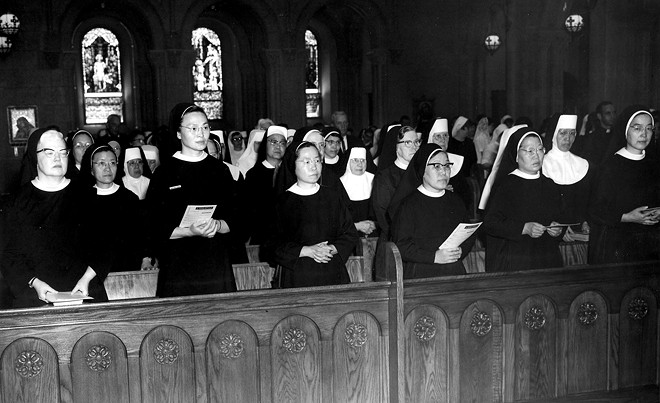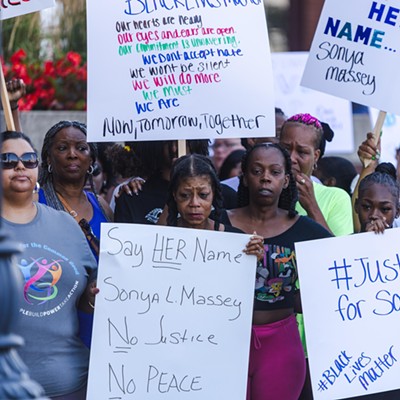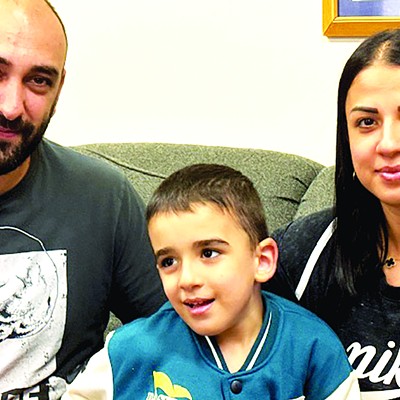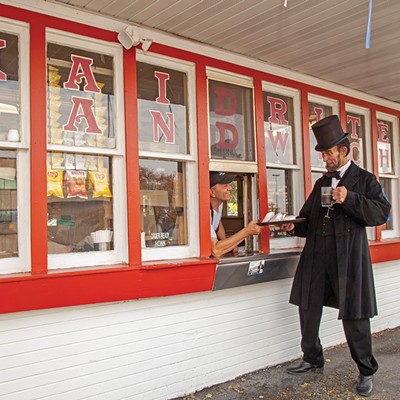An immigrant who first arrived in Springfield in 1948 received only three hours' notice to leave her native country of China. The year before, on Christmas Eve, one of her brothers had informed her that "Chinese communist" insurgents had killed their father, mother, sisters and other brothers in a period of religious persecution. As political tensions mounted, she and 15 others grabbed a few belongings and boarded the SS General Meigs in Shanghai and spent 25 days traveling by boat and train – destination Springfield, Illinois. All 16 refugees were Franciscan sisters with their motherhouse being the American Province of the Hospital Sisters of St. Francis.
Now 103 years old, Sister Pacis Bao is the last one remaining of the 35 native Chinese sisters who entered the Springfield-based religious community and served in China, the United States and Taiwan. The second-to-last survivor, Sister Therese Fang, died in Springfield in May 2023 at the age of 102.

Born in Shan-Tung, China, in 1921, Bao Yuan Ying – as she was originally known – was the youngest of seven children. When she was a little girl, Japan invaded China and engaged in skirmishes in mainland China, and the Sino-Japanese War eventually became part of the Pacific theater of World War II. The Japanese oppressed Catholics and Chinese landowners, which prompted Yuan Ying's family to place her in an orphanage for her safety. Yuan Ying says for some reason she had a favored status with her father, who wanted her to be a doctor.
Later she was enrolled in a school in Jinan, about 120 miles away, with visits to her family allowed only twice a year. As a high school student, she had her first contact with the Hospital Sisters, who had opened St. Joseph's Hospital in Jinan in 1926 and visited her school in 1940 to speak about their missionary health care work and vocations to religious life.
On one visit in the 1940s, her brother, Peter, took her from the school to the hospital in the same city to see "a friend," who turned out to be the Franciscan superior, Sister Clementia Dasenbrock. An American from Lillyville, Illinois, Sister Clementia had volunteered to be a missionary in China in 1927. Peter had made arrangements ahead of time for Yuan Ying to stay behind at the hospital, but she was surprised when he left her there alone. It was wartime, with China on the side of the Allies against the Japanese, but also with many Chinese people becoming wary of the growing influence of the Chinese communists. Asked if she became afraid when she was left behind, she joked, "I was too dumb to be scared."
The sisters gave the young Yuan Ying a job in the hospital pharmacy, and she felt safe there. The sisters' simplicity and cheerfulness impressed Yuan Ying. She formally entered the community in 1944 and a year later was given the name Sister Pacis (meaning "peace" because of the 1945 peace treaty that was signed). She did not yet have formal nursing training.
During World War II, from 1943-45, about a dozen Franciscan sisters from America, including Sister Clementia, were among 2,200 civilians from Allied countries held by the Japanese in the Weihsien Internment Camp before being relocated to a convent (but still detained) in Peking. They were freed when the war ended in 1945.
Sister Pacis professed her first vows in 1947, only to face the abrupt relocation to Springfield a year later. She and the other sisters who arrived unexpectedly in Springfield in 1948 thought they would return to China within three years. "Clementia said to learn as much as possible" because they would be going back to China to run the hospital in Jinan, Sister Pacis said. But that did not happen. They had limited or no contact with their families for the next 30 years.
Sister Pacis, who had learned some English as a child, and the other native Chinese Franciscans, continued to learn English and serve in health care. She worked as a nurse aide and cared for other sisters at the motherhouse in Springfield and became an American citizen. After working part time as a nurse aide at St. John's Hospital, Sister Pacis became a student at St. John's Hospital School of Nursing. After graduating, she worked from 1963 to 1967 as a registered nurse at St. John's, and from 1967-68 she was a nurse at St. Vincent Hospital in Green Bay, Wisconsin.
Then another missionary call came, this time to serve the poor in the Chi Chin District in Kaohsiung, Taiwan. The Franciscans established the Star of the Sea Clinic in 1968 in a poor, underdeveloped area. Sister Pacis, one of five sisters chosen for this mission, describes it as "very dirty" there.

She recalled an incident in which a man was injured after falling from a scaffold. "It was terrible," she said. "I put my head next to the tabernacle in the chapel and said, 'Jesus, you have to help.' I prayed all night." Then she got word that miraculously, the man had only minor injuries. "I didn't want to stay in Taiwan, but I promised God, and it was a miracle. I stayed for 33 years," Sister Pacis recalled.
Sister Pacis was finally able to return to China in 2000 – 52 years after she left – and then three more times to visit with her nephew and his family. Her own family had been killed, news that haunted her for decades.
"For 50 years I just felt the bitterness, all the hatred in my insides," she now says. "I know the communists killed them. I always thought that I would get revenge. I wanted to take a chance and go to China and kill all the communists." But two years before she left Taiwan, the bishop of Kaohsiung invited her to a prayer service for those who had suffered persecution. That proved to be a moment of conversion for her at the age of 79. She discovered that without forgiving, she was not at peace. She explains:
"I wanted to forgive. I asked the Lord because to get revenge is not Christian. I needed help. I needed everybody's help. My prayer is not sufficient. So I went to this reconciliation. There were over 5,000 of us in this meeting. I think the Holy Spirit was present – he touched our souls; touched our minds. When I came back from this meeting, I felt at peace. I forgive them. That is how a person gets converted."
Since returning to Springfield in 2002, she has remained active. Initially, she was faithful to an hour of prayer before the Blessed Sacrament each day, tended to a vegetable and flower garden, cooked Chinese food, communicated through email and played FreeCell on the computer. In more recent years, she continues to devote an hour of prayer each day before the Blessed Sacrament and also paints.
And she inspires others with her quiet, soft-spoken presence, which she says is radiating Jesus' presence in her. With a big smile, she says, "Jesus is my best friend."
Hospital Sisters' Communications Director Brian Blasco believes that God had a plan for Yuan Ying (Sister Pacis) all along.
"The wisdom of her father to move her away from their home saved her life, as most of her family were killed because they were Catholic and landowners," he said. "Sister Pacis continues to fulfill her calling through God's desire for her to be among us for more than 100 years. She is a living witness of love, forgiveness, spirituality and joy. She is a reminder that as we journey through this life, we are here to make a difference – to recognize each encounter as an opportunity to be present."
Ed Wojcicki, who retired from University of Illinois Springfield and from the Illinois Association of Chiefs of Police, is a freelance writer from Springfield.
Timeline
1921: Bao Yuan Ying is born in Shan-Tung, China, the
youngest of seven children in a prosperous Catholic family.
1925: The American Province of the Hospital Sisters of St.
Francis, based in Springfield, opens a mission and builds St. Joseph’s Hospital
in Jinan, China (also known as Tsinanfu).
1925: The family places Yuan Ying in an orphanage in a
nearby village for her safety.
1932: One of her brothers enrolls her in a school in Jinan,
about 120 miles away.
1944: After interaction with the Hospital Sisters while in
high school, Yuan Ying joins the community. A year later, she is given the name
Sister Pacis.
1948: Sister Pacis and 15 other Franciscans leave China and
take 25 days by boat and train to arrive at the Franciscan Motherhouse in
Springfield.
1963: Sister Pacis graduates from St. John’s Hospital School
of Nursing and works as an RN at St. John’s and later at St. Vincent Hospital
in Green Bay, Wisconsin.
1968: The Hospital Sisters open a mission in Kaohsiung,
Taiwan, and Sister Pacis, along with four other Chinese native sisters,
volunteer to serve as missionaries. She serves for 34 years.
2002: Sister Pacis returns to Springfield and lives with and
serves others at St. Francis Convent.
Hospital Sisters of St. Francis establishes a presence in
China
The Hospital Sisters of St. Francis established St. Joseph’s
Hospital in Jinan after being asked to provide health care and do missionary
work in that country. A modern building for its time, it was a three-story
brick structure with running water and electric lights. Over the next 24 years,
they provided health care at St. Joseph’s and in medical clinics they set up in
several villages. Overall, the Springfield-based American province sent 26
sisters to be missionaries in China and attracted 35 native Chinese women to
join the community.
When most had to leave in 1948, three native Chinese
Franciscans stayed to work at the hospital. One of those, Sister Assunta Liu,
grew in despair and committed suicide in 1969. The other two died in 1987, with
the death of Sister Odorika Lin ending the Franciscan missionary presence in
mainland China.
“The legacy of our mission in China is humbling as I
recognize that these missionaries brought life to St. Francis of Assisi’s
message: ‘Lord, make me an instrument of your peace,’” said Sister Maureen
O’Connor, who has been Superior of the Hospital Sisters of St. Francis for nine
years. “These sisters shared the love of Christ through acts of kindness to the
people they served, often in challenging political, social and environmental
circumstances.”
Eventually, the original St. Joseph’s Hospital in Jinan was
torn down. On its site was built a much larger Jinan Second People’s Hospital,
which is thriving. The current hospital memorializes the Franciscans’ presence
by displaying the cornerstone of St. Joseph’s Hospital in its lobby.
–
Ed Wojcicki





















